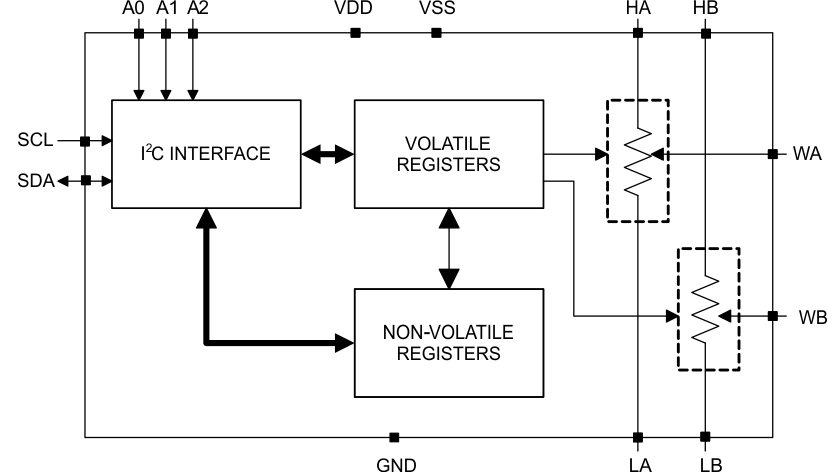ZHCSE79C March 2011 – September 2015
PRODUCTION DATA.
- 1 特性
- 2 应用
- 3 说明
- 4 修订历史记录
- 5 Pin Configuration and Functions
- 6 Specifications
-
7 Detailed Description
- 7.1 Overview
- 7.2 Functional Block Diagram
- 7.3 Feature Description
- 7.4 Device Functional Modes
- 7.5 Programming with I2C
- 7.6
Register Maps
- 7.6.1 Slave Address
- 7.6.2 TPL0102 Register Map
- 7.6.3 IVRA (Initial Value Register for Potentiometer A)
- 7.6.4 WRA (Wiper Resistance Register for Potentiometer A)
- 7.6.5 IVRB (Initial Value Register for Potentiometer B)
- 7.6.6 WRB (Wiper Resistance Register for Potentiometer B)
- 7.6.7 ACR (Access Control Register)
- 8 Application and Implementation
- 9 Power Supply Recommendations
- 10Layout
- 11器件和文档支持
- 12机械、封装和可订购信息
封装选项
机械数据 (封装 | 引脚)
散热焊盘机械数据 (封装 | 引脚)
- RUC|14
订购信息
1 特性
- 两个分辨率为 256 个位置的电位计
- 非易失性存储器存储抽头设置
- 100kΩ 端到端电阻 (TPL0102-100)
- 短暂的抽头设置上电响应时间:< 100µs
- ±0.5 最低有效位 (LSB) 积分非线性 (INL),±0.25 LSB 微分非线性 (DNL)(分压模式)
- 4ppm/°C 比例温度系数
- 兼容 I2C 的串行接口
- 2.7V 至 5.5V 单电源运行
- ±2.25V 至 ±2.75V 双电源运行
- 工作温度范围:-40°C 至 85°C
- 关断模式
- 静电放电 (ESD) 性能测试符合 JESD 22 标准
- 2000V 人体模型(A114-B,II 类)
- 1000V 充电器件模型 (C101)
2 应用
- 可调节增益放大器和偏移修整
- 可调节电源
- 设定点阈值的精度校准
- 传感器微调和校准
- 机械电位器的替代产品
3 说明
TPL0102 配有两个具备 256 个抽头位置的线性抽头数字电位计 (DPOT)。每个分压器可用作三端分压器或者两端变阻器。TPL0102-100 具有一个 100kΩ 端到端电阻。
TPL0102 配有非易失性存储器 (EEPROM),可用于存储抽头位置。这一点的优势是即使在掉电期间也可存储抽头位置。因此,再次上电时便可自动恢复抽头位置。TPL0102 的内部寄存器可以使用 I2C 接口进行访问。
TPL0102 采用 14 引脚 MicroQFN 和 14 引脚薄型小外形尺寸 (TSSOP) 封装,额定温度范围为 -40°C 至 85°C。
器件信息(1)
| 器件型号 | 封装 | 封装尺寸(标称值) |
|---|---|---|
| TPL0102 | X2QFN (14) | 2.00mm x 2.00mm |
| TSSOP (14) | 5.00mm x 4.40mm |
- 要了解所有可用封装,请见数据表末尾的可订购产品附录。
简化电路原理图
